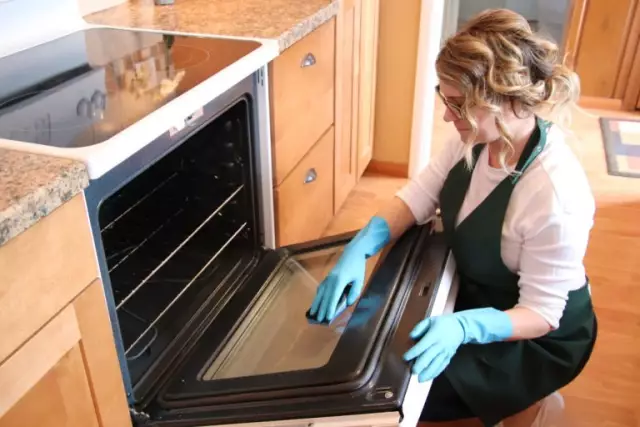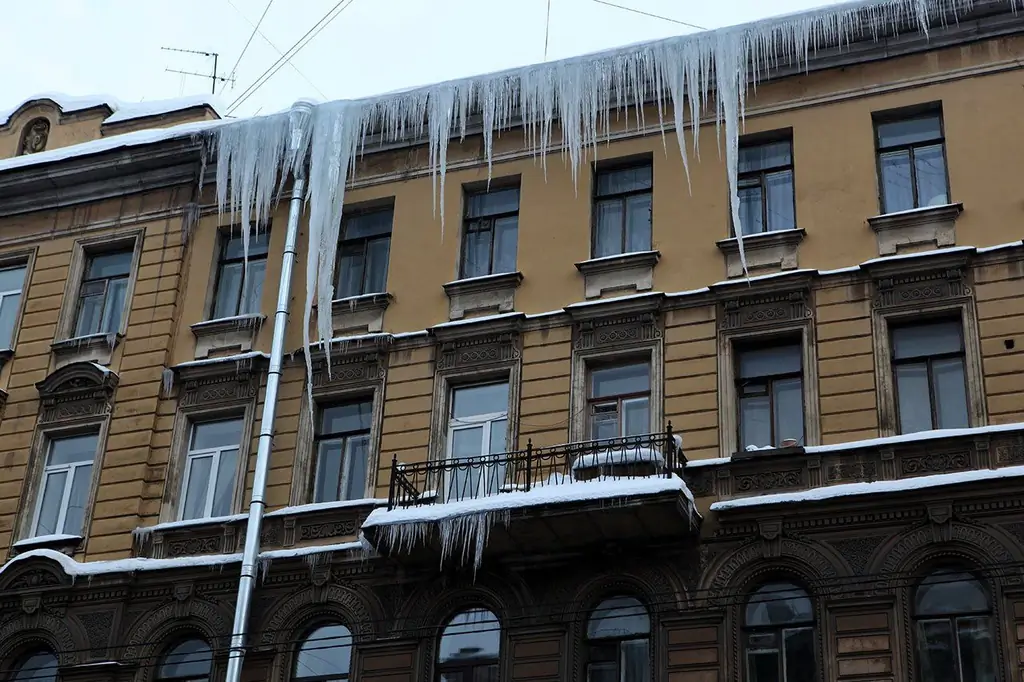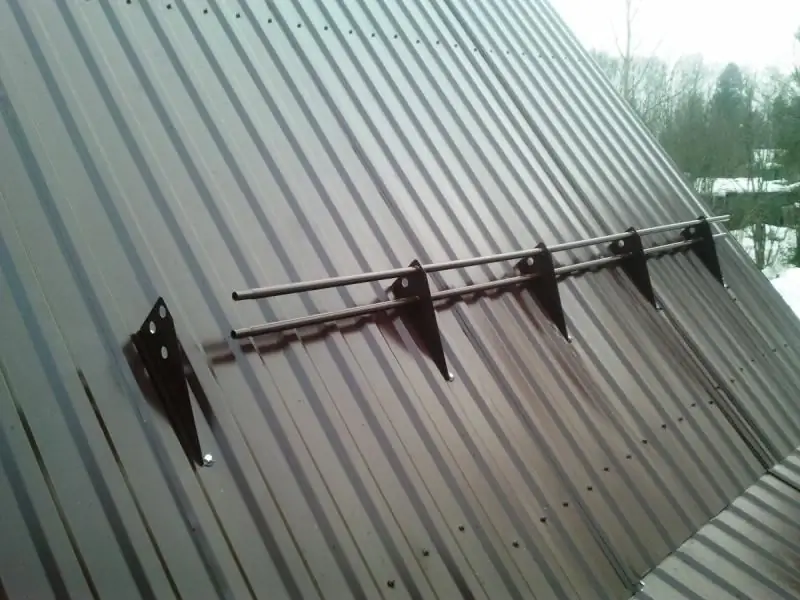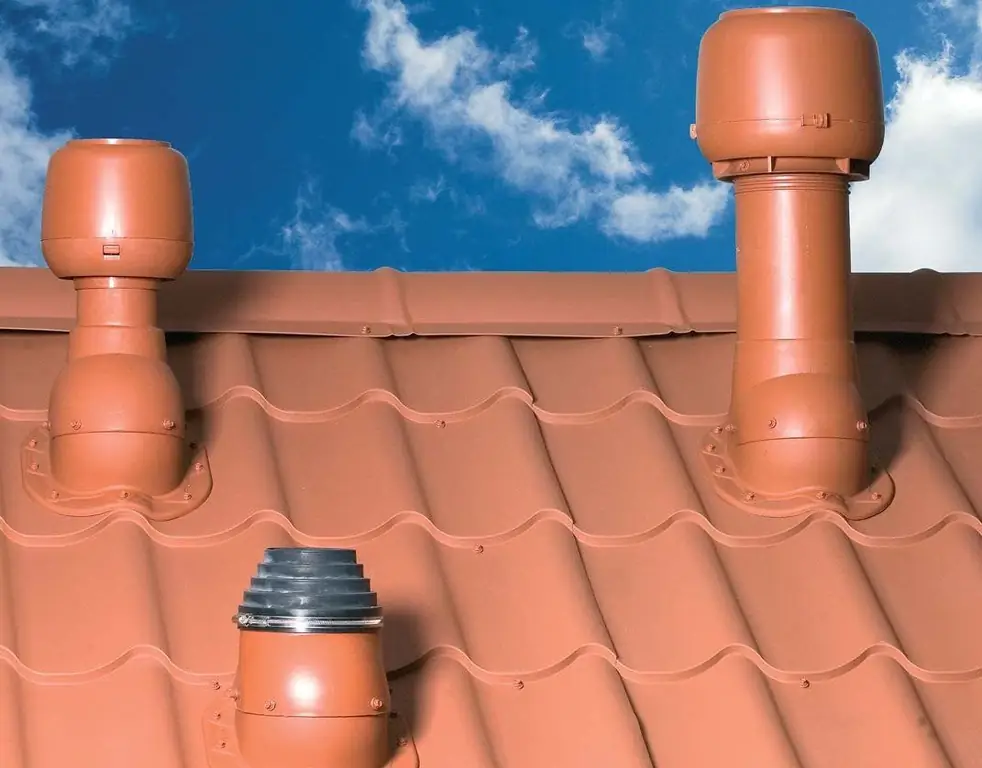
Table of contents:
- Author Bailey Albertson [email protected].
- Public 2024-01-17 22:26.
- Last modified 2025-01-23 12:41.
Getting rid of snow and ice on the roof: the most effective measures

Our country is located in different climatic zones, where along with frosty winters there are frequent thaws with snowfalls and subsequent frosts. In such extreme conditions, ice, icicles and snow deposits of considerable thickness and, therefore, considerable weight are formed on the roofs. Uncontrolled descent of large masses of snow and ice poses a danger to people, and a multi-ton accumulation of snow can destroy the rafter structures. There are methods for controlling the critical thickness of the snow cover on the roof, which help to clear the roof of snow and ice in a timely manner. And there are also modern ways to combat the accumulation of winter precipitation on the roofs of buildings.
Content
-
1 Calculation of snow load on the roof
- 1.1 Photo gallery: snow accumulations on the roof
-
1.2 Methods for controlling snow load on the roof
1.2.1 Table: snow weight depending on precipitation structure
-
2 Methods for cleaning the roof from snow
- 2.1 Rules for cleaning the roof from snow
- 2.2 Devices and tools for cleaning roofs from snow and ice
- 2.3 Photo Gallery: Tools for Roofing
-
3 Use of anti-icing systems
- 3.1 Methods for De-icing the Roof
- 3.2 Roof anti-icing systems
- 3.3 Photo gallery: elements of installation of the roof heating system
- 3.4 Recommendations for the use of de-icing devices on roofs
- 3.5 Video: installation of the roof de-icing system
Calculation of snow load on the roof
It is necessary to control the snow load on the roof of buildings because a large weight of ice and snow can lead to the destruction of the rafters and ildargm56: 05.10.2017, 18:13 the
generally accepted term
"> roofing cake. With heavy loads on the roof of the structure, design errors and miscalculations become obvious during installation.

Failure of the rafter system, a small angle of inclination of the slopes leads to unpleasant consequences
With an excessive accumulation of snow masses on the roof of a building, there are risks of sudden melting of snow layers, which leads to unpredictable consequences and threatens human health. It is also necessary to control the weight load on the roof truss system, since excessive pressure can deform or completely destroy the frame structure. The following types are most likely to accumulate snow masses:
- lean-or gable roof with an inclination of less than 15 on;
- joints of pitched roofs with a vertical wall;
- complex multi-gable structures at the junction of planes with different angles of inclination;
- roofs made of non-metallic materials with a high coefficient of friction;
- roofs built without taking into account the wind rose of your region in the winter.
The listed types of roofs require constant visual or remote control over the thickness of the snow mass, which is based on the calculation of the weight of snow per 1 m2 of roof area and other methods.
Photo Gallery: Snow Clumps on the Roof
-

Snow on the roof - The small angle of inclination of the slope leads to increased load on the roof
-

Snow on the roof - The accumulation of snow at the junction overloads the rafter system
-

Wind sediment - If the prevailing winds are not taken into account when building a house, there will be constant problems with snow on the roof.
Methods for controlling snow load on the roof
For effective control, it is necessary to take into account the maximum load capacity of the roofing material and the rafter structure. There are special calculators for calculating the snow load, as well as SNiP and SP 20.13330.2016, but they are difficult to use. Here is a simplified formula for calculating the total weight of snow: P full. = N x P calc., Where:
- N is an indicator of the angle of inclination of the roof slopes, the slope coefficient at an angle of inclination less than 25 o is equal to 1, at 25 o -60 o is 0.7, and at angles of more than 60 o is not taken into account;
- P calc. - weight value of snow cover per 1 m 2, kg / m 2;
- P full - total weight of snow per m 2 of the roof, kg / m 2.
Temperature conditions and the structure of precipitation do not always allow us to accurately determine the weight of snow without the use of laboratory studies, which are not cheap. There is no need to use expensive data under normal conditions, an assessment table can help, which will greatly simplify the visual assessment of the snow load on the roof.
Table: weight of snow depending on the structure of precipitation
| Type of snow and ice | Weight in kg / m 3 |
|---|---|
| Fluffy dry fresh | from 30 to 70 |
| Wet fresh | from 70 to 160 |
| Settled fresh | from 180 to 300 |
| Dry | from 120 to 130 |
| Wet | from 800 to 950 |
| Wind sediment | from 200 to 300 |
| Firn or ice | from 500 to 960 |
Based on the calculation formulas and the data in the table, you can calculate the load on the roof and determine the need to clean the roof from snow and ice. If there is no data on the load capacity of the rafter structure and roofing, then it is necessary to carry out periodic visual inspection of the serviceability of these elements.

Temperature conditions and rainfall patterns do not always allow us to accurately determine the weight of snow without the use of laboratory studies, which are not cheap
In addition to calculated and tabular data, there are other methods for monitoring the state of snow cover on roofs of various types. They consist in remote video surveillance or remote control using a computerized system with sensors such as "TOKVES" BBA or other strain gauges. Due to the high cost, such systems are installed in shopping centers, stadiums and cultural and entertainment complexes. The set of remote control equipment consists of the following components:
- bracket with a reinforced snow depth sensor;
- a data transmission unit with an external temperature measuring device;
- a receiving device connected to a computer;
- computer with software for data processing and system control;
- monitor for visualization and manipulators.
The advantages of this control system are to analyze the true, rather than the calculated, snow depth at different roof locations.
Methods for cleaning the roof from snow
Manual cleaning of the roof from accumulations of snow and ice requires significant physical effort and is dangerous for humans. The use of equipment, including those based on vibration effects on the roof, does not give the expected result. This is because individual architectural solutions do not allow the use of mechanisms, and vibration violates the integrity of the roofing. The following methods of cleaning roofs from snow are used:
- mechanical, in which manual discharge of snow and ice is used, including from a telescopic tower based on a car;
- chemical, using salt and reagents;
- method of applying hydrophobic films;
- technical method in which controlled heating of the roof and drainage systems is performed;
- preventive measures associated with the correct choice of the angle of inclination of the slopes and high-quality thermal insulation of the roof.
The use of these cleaning methods is associated with work at high altitudes and is a particularly hazardous activity. It is very important to comply with safety rules during work at heights and to provide performers with serviceable tools, overalls and shoes, as well as to use safety devices.

The mechanical method of cleaning the roof from accumulations of snow and ice requires significant physical effort
Rules for cleaning the roof from snow
High-rise work is carried out according to certain rules and regulations, the implementation of which is mandatory. Safe working conditions are ensured by the availability of serviceable ladders, tools, overalls, helmets and non-slip shoes. Special attention should be paid to safety ropes with adjustable length and diameter from 8 mm, which are attached to reliable supports of the first category. With a mechanical cleaning method with manual dumping of snow and ice, there are separate rules, which are as follows:
- Cleaning is carried out during daylight hours by a team of at least three people after instruction on safety rules for work at height.
- The place of discharge is fenced off at a distance of 5 to 10 m from the zone of falling snow and ice, an attendant is set up, who ensures the safe passage of people and has voice or radio communication with high-altitude workers.
- The roof is cleaned from eaves to ridge without compromising the integrity of the roofing, television or other cables.
- A layer of snow and ice with a thickness of 2 to 5 cm is left on the roof, which protects the coating from damage.
- Hanging icicles are chipped off with special picks or other devices that ensure the integrity of the drainage system.
Chemicals are scattered on the roof using rubber gloves, and the hydrophobic coating is applied to the roof by roller or spray in workwear using respirators. Installation of roof heating elements and snow holders is carried out with a serviceable power tool and other equipment (ladders, couplings, clips). For all work, it is mandatory to use a helmet and safety ropes.
Devices and tools for cleaning roofs from snow and ice
When cleaning roofs manually, tools are used to ensure effective cleaning and do not damage the roofing material. Shovels are used plastic or wood without cutting inserts, and saws on long cuttings are suitable for cutting snow. Picks or scrapers are used to remove icicles from the cornice. When removing overhanging layers of snow and ice, you can use telescopic towers that allow you to quickly and safely get the job done. Chemical cleaning using salt and reagents does not require tools, but the disadvantage of this method is increased corrosion of the metal coating and disruption of the drainage system. The application of hydrophobic coatings to a clean roof is carried out with the use of rollers, brushes and spray guns, it facilitates the snow from the roof, but does not solve the problem of icing on the roof. In some cases, sliding ladders, hydraulic lifts and electrically powered cradles are used. The most effective is the technical cleaning method, which we will discuss in detail in the next chapter.
Photo gallery: tools for working on the roof
-

Girl with a plastic snow shovel - Plastic shovels are suitable for gentle cleaning of the roof
-

Double volume - Pushers are used for faster cleaning
-

Removing icicles from the roof - Pickaxes or scrapers are suitable for removing icicles.
Use of anti-icing systems
The simplest way to deal with ice on the roof is the correct choice of the angle of inclination of the slopes and the professionally performed insulation and ventilation of the roof. This passive protection is carried out at the design and construction stage and should be carried out taking into account the prevailing winds in the region where the development is taking place. Taking these factors into account allows you to save significant financial resources in the future. For existing buildings, different methods of protecting the roof from snow and ice are used.
Roof deicing methods
Icing can be controlled by highly effective thermal insulation of the residential part of the building from the under-roof space. This method provides the same temperature of the external environment and the attic, which makes ice formation impossible. The disadvantage is that with the alternation of positive and negative average daily temperatures, it is impossible to completely eliminate the formation of ice on the roof and eaves.
There are a number of de-icing methods using technical means that gently affect the roofing material and eliminate the accumulation of snow and ice in critical areas of the roof. One of the technical methods is the electric pulse method of influencing the roof overhang. It is produced by applying a short-term pulse to the inductors, which is converted into mechanical vibration, which leads to the destruction of the ice crust on the roof. This method, unfortunately, has not become widespread because its effect is limited and does not solve the problem of anti-icing of the entire roof.
The most productive is the temperature method of anti-icing, which uses heating of the cable located in problem areas of the roof.
Roof anti-icing systems
To combat ice formation on the roof of buildings, the method of temperature exposure to the roof and drainage systems is widely used. Icing systems differ in the way the heating is controlled and the sensors and controllers used. Control can be manual or automatic, and in some cases controlled remotely using computer technology. When heating roofs, gutters, funnels and downpipes, a cable with constant or variable resistance is used, the heating of which is controlled by the controller. Economy and efficiency is achieved by using sensors operating in the temperature range from +5 o C to -10 o C. The combination of such technical elements, ensuring trouble-free operation and electrical safety, gives the following advantages:
- the system is turned on when the temperature and humidity sensors are triggered and in the presence of snow and ice, which saves electricity;
- control over the cable parameters is carried out autonomously, which guarantees constant power, no overheating and ensures electrical safety;
- the presence of a controller excludes starting currents and voltage drops;
- the work of the entire system occurs without human intervention.
Photo gallery: elements of installation of a roof heating system
-

Roof heating system - The most effective is the scheme in which the cable is used to simultaneously heat the valleys, the roof overhang and the drainage system
-

Heated drainage system - The cable on the funnel is laid along the walls
-

Draining - Downpipe heating cable mounted on a chain
-

Roof heating controller - Automated roof heating control kit saves time
When installing heating elements, cables in various designs are used, which differ significantly in cost. The most widespread are resistive cables of various designs. The single-core cable consists of a heating core, double insulation and copper braid, which shields electromagnetic interference and provides sufficient protection against mechanical influences. The two-core cable consists of a heating and return conductor in three-layer insulation. The most expensive of the resistive cables is the sectional modification, in which, in addition to two cores, a tungsten filament is used for the most efficient heating. The disadvantage of a resistive system is that the entire cable is heated, which leads to excessive consumption of electricity, despite the presence of sensors. Self-regulating cable is devoid of these shortcomings and consists of two conductors,between which there is a semiconductor film. The lower the outside temperature, the more conductive lines with a given resistance appear in the film, and this leads to greater heating and ice melting.
A self-regulating cable is resistant to mechanical stress and does not need automated control systems because it heats up only in areas with low temperatures, and this saves energy and money
Recommendations for the use of de-icing devices on roofs
To make the best use of the potential of a roof heating system, a careful comparative analysis of the price and quality of different types of equipment and cable types is required. You need to make sure that the equipment is complete with fire detectors, the availability of warranty obligations of the manufacturer and service centers in your region. To save money, you can use the following recommendations:
- the cable is installed in the area of joints of multi-gable roofs, valleys, overhangs and in the drainage system;
- in some cases, it is advisable to use a two-core cable in one row;
- in critical areas, you can use a self-regulating cable, and mount a cheaper resistive cable along the overhang;
- in long drainpipes, cables or thin chains must be used to avoid cable breakage;
- to protect the cable from the uncontrolled descent of snow masses, it is necessary to install snow retention systems.
It should be noted that self-installation is possible with certain knowledge and skills, but the debugging of the automation system should be entrusted to specialists
Video: installation of a roof de-icing system
We examined the methods of cleaning the roof from snow and ice, as well as the types of control over the amount of snow load on the roof. The article reflects the most popular methods of mechanical, chemical, emulsion and technical control of snow and ice accumulations. It is important to consider that you can get rid of these problems even at the stage of building a country house or summer cottage. For this, whenever possible, it is necessary to follow the recommendations of professional planners and designers.
Recommended:
How To Clean A Stove With Your Own Hands - Repair, Cleaning A Brick Russian, Bath, Round Stove From Soot Without Disassembling Why It Does Not Heat Well, Reasons, Cleaning Wells, G

How to repair and clean the oven with your own hands. Types of repair, when and why you need it. List of necessary tools and nuances to consider
Icicles On The Roof Of The House, How To Get Rid Of Them, As Well As A Device And Tool For Removing Ice

The reasons for the appearance of icicles on the roofs and how to get rid of them. Methods to prevent the formation of ice. How to protect yourself from falling icicles
Snow Holders On A Roof Made Of Corrugated Board, Including An Overview Of The Varieties, As Well As How To Correctly Calculate And Install

Do you need snow holders for a roof made of corrugated board. Types of barriers. Correct installation of snow guards and calculation of their number
Roof Ventilation, Its Elements And Purpose, As Well As How To Correctly Calculate And Organize

Factors that determine the need for a roof ventilation device. Types of ventilation elements, their design features and methods of application
Snow Guards On The Roof, Including An Overview Of The Varieties, As Well As How To Calculate And Install Correctly

Snow holders: purpose and varieties. Installation on roofs with different coatings. Calculation of the required number of snow holders
